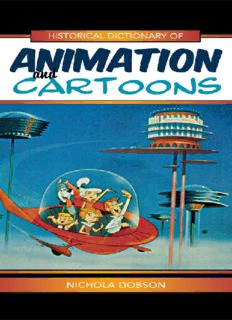
Historical Dictionary of Animation and Cartoons PDF
Preview Historical Dictionary of Animation and Cartoons
HISTORICAL DICTIONARIES OF LITERATURE AND THE ARTS Jon Woronoff, Series Editor 1. Science Fiction Literature, by Brian Stableford, 2004. 2. Hong Kong Cinema, by Lisa Odham Stokes, 2007. 3. American Radio Soap Operas, by Jim Cox, 2005. 4. Japanese Traditional Theatre, by Samuel L. Leiter, 2006. 5. Fantasy Literature, by Brian Stableford, 2005. 6. Australian and New Zealand Cinema, by Albert Moran and Errol Vieth, 2006. 7. African-American Television, by Kathleen Fearn-Banks, 2006. 8. Lesbian Literature, by Meredith Miller, 2006. 9. Scandinavian Literature and Theater, by Jan Sjivik, 2006. 10. British Radio, by SeBn Street, 2006. 11. German Theater, by William Grange, 2006. 12. African American Cinema, by S. Torriano Berry and Venise Berry, 2006. 13. Sacred Music, by Joseph P. Swain, 2006. 14. Russian Theater, by Laurence Senelick, 2007. 15. French Cinema, by Dayna Oscherwitz and MaryEllen Higgins, 2007. 16. Postmodernist Literature and Theater, by Fran Mason, 2007. 17. Irish Cinema, by Roderick Flynn and Pat Brereton, 2007. 18. Australian Radio and Television, by Albert Moran and Chris Keating, 2007 19. Polish Cinema, by Marek Haltof, 2007. 20. Old Time Radio, by Robert C. Reinehr and Jon D. Swartz, 2008. 21. Renaissance Art, by Lilian H. Zirpolo, 2008. 22. Broadway Musical, by William A. Everett and Paul R. Laird, 2008. 23. American Theater: Modernism, by James Fisher and Felicia Hardison LondrC, 2008. 24. German Cinema, by Robert C. Reimer and Carol J. Reimer, 2008. 25. Horror Cinema, by Peter Hutchings, 2008. 26. Westerns in Cinema, by Paul Varner, 2008. 27. Chinese Theater, by Tan Ye, 2008. 28. Italian Cinema, by Gino Moliterno, 2008. 29. Architecture, by Allison Lee Palmer, 2008. 30. Russian and Soviet Cinema, by Peter Rollberg, 2008. 3 1. African American Theater, by Anthony D. Hill, 2009. 32. Postwar German Literature, by William Grange, 2009. 33. Modern Japanese Literature and Theater, by J. Scott Miller, 2009. 34. Animation and Cartoons, by Nichola Dobson, 2009. Historical Dictionary of Animation and Cartoons Nichola Dobson Historical Dictionaries of Literature, and the Arts, No. 34 The Scarecrow Press, Inc. Lanham Toronto Plymouth, UK 2009 Published by Scarecrow Press, Inc. A wholly owned subsidiary of The Rowman & Littlefield Publishing Group, Inc. 4501 Forbes Boulevard, Suite 200, I~nhamM, aryland 20706 http://w\vw.scarecrowpress.com Estover Road, Plymouth PL6 7PY, United Kingdom Copyright O 2009 by Nichola Dobson All rights reserved. No part of this book may be reproduced in any form or by any electronic or mechanical means, including information storage and retrieval systems, without written permission from the publisher, except by a reviewer who may quote passages in a review. British Library Cataloguing in Publication Information Available Library of Congress Cataloging-in-Publication Data Dobson, Nichola, 1976- Historical dictionary of animation and cartoons / Nichola Dobson. p. cm. - (Historical dictionaries of literature and the arts ; no. 34) Includes bibliographical references. ISBN 978-0-8108-5830-5 (hardcover : alk. paper) - ISBN 978-0-8108-6323-1 (eb ook) 1. Animated films-Dictionaries. I. Title. PN 1997.5.D63 2009 79 1.43'3403 -dc22 2009017015 aTM The paper used in this publication meets the minimum requirements of American National Standard for Information Sciences-Permanence of Paper for Printed Library Materials, ANSIINISO 239.48-1 992. Printed in the United States of America For my husband, Jonny Contents Editor's Foreword Jon WoronofS i x Preface xi .. . Acknowledgments Xlll Acronyms and Abbreviations xv Chronology xvii Introduction xxxv THE DICTIONARY 1 Appendix: Academy Award Winners 219 Bibliography 223 About the Author 245 Editor's Foreword Once upon a time animation was a relatively simple matter, using fairly primitive means to produce rather short films of subjects that were generally comedic and often quite childish. Much of this was just filler for more serious stuff. Since then, things have changed-and they keep on changing at a maddening pace that looks like a cartoon being fast- forwarded. One new technique after another has made it easier, faster, and above all, cheaper to produce the material. This material has taken on an increasing variety of forms-not just drawings but also clay and plastic bricks and other solid matter-that are now being leapfrogged by computer-assisted techniques and other advanced technologies that provide different and usually better viewing. Sound has also improved phenomenally. But the real revolution has been in content. With all due apologies to Donald Duck and friends, we now have not only feature- length films-which is nothing really special since it is only a question of a longer showing time- but also increasingly sophisticated stories, many still amusing (nothing has truly replaced comedy) but others quite serious, dealing with heavier issues like the environment, personal and generational conflicts, warfare, and indeed, the end of life as we know it. Wow! This is almost mind-boggling, except that there is certainly more to come, with games and interactive animation and things we can- not even conceive of yet. So it is not only a pleasure but almost an obligation to include a His- torical Dictionary of Animation and Cartoons in the Literature and Arts series. It starts by tracing the path of animation from its rather simple beginnings about a century and a half ago to the complicated and hectic pace it is setting at present. The introduction helps put things in perspec- tive and not only considers the past and the present but also peers into the future. The bulk of the information comes in the dictionary section. Many of these entries deal with leading figures on the technical, creative,
Description: